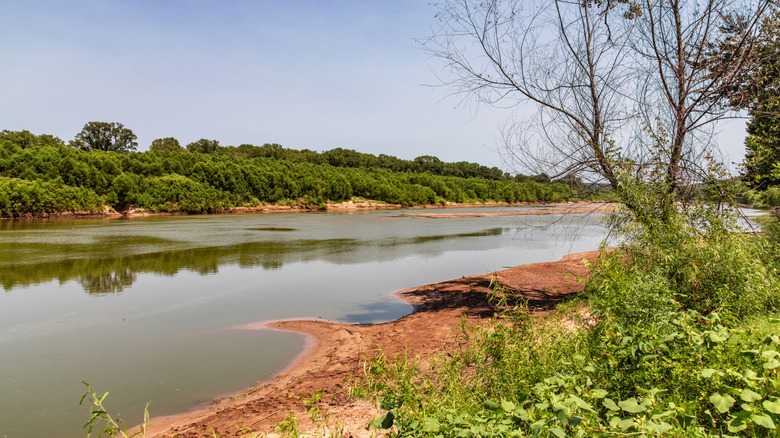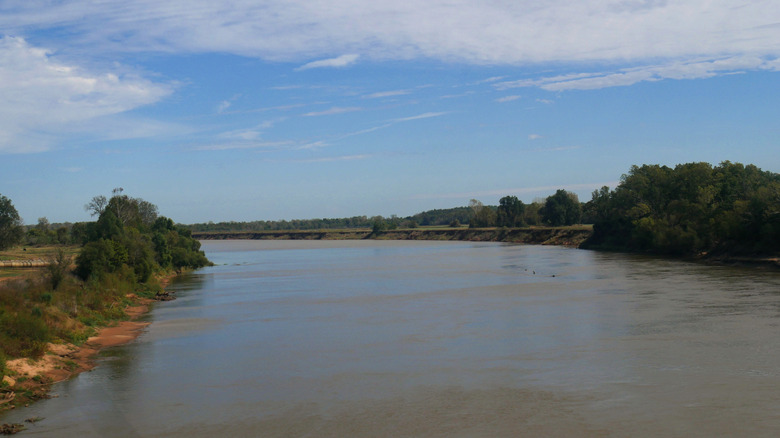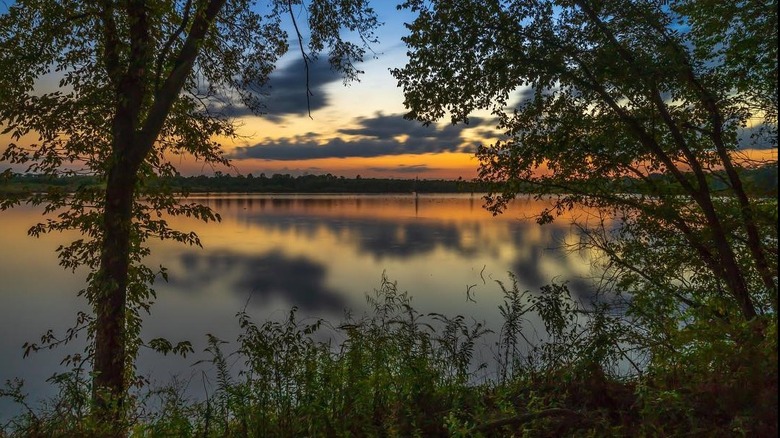One Of America's Largest Rivers Has Historic Trails From Texas To Arkansas, Recreation, And Southern Charm
At around 1,360 miles, the Red River (sometimes called the Red River of the South) is longer than the Ohio River, as well as the Pacific Northwest's Columbia and Snake Rivers. Beginning in the Texas panhandle, the Red River flows eastward across the state and ends near Simmesport, Louisiana, where it connects to the Mississippi River via the Atchafalaya. For about half of its journey, the Red River serves as the natural boundary between the Texas-Oklahoma border, a place full of adventure.
In the 1800s, the Chisholm Trail network, used to move cattle across the Lone Star State (and as far north as Kansas), crossed over the Red River. Today, much of the river traverses northern Texas through private lands, so it remains off most travelers' radars. The river has a slightly reddish, muddy shade because of the soil surrounding its banks and a high salt content due to the salt pockets that formed in ancient times. However, there are a handful of state parks and national wildlife preserves along the river that still provide public access and both camping and hiking opportunities.
The river passes several charming Southern cities and towns, including Alexandria, an underrated city in the heart of Louisiana, which is a dynamic hub of Creole culture. It also flows just north of the city of Wichita Falls, a foodie gem that's considered one of the most affordable cities in Texas. It's also home to a beautiful central park with a man-made waterfall. While much of the Red River is considered a "muddy prairie river," some sections provide a chance for kayaking and canoeing, not to mention all the scenic trails to explore.
Exploring the Red River
The Denison Dam forms the Lake Texoma reservoir on the Oklahoma and Texas border and is where the Red River reaches its widest point. Here, the river becomes clearer and navigable for personal watercraft; the area is offers a plethora of marinas, watersports, and nearby campgrounds. The lake itself is a popular tourist destination, and kayaks, paddleboards, pontoon boats, and paddle boats can be rented from places like Lighthouse Resort Marina. Alternatively, visitors can hop aboard a sunset or dinner cruise. The shores of Lake Texoma are also home to Eisenhower State Park, which is popular for fishing or hiking the cliff bluffs that run along the lake. Camping is also available in rustic cabins or at standard tent campsites.
Those interested in hiking trails along the river in northern Texas can check out the Red River Loop, a collection of wildlife refuge areas about two hours east of Lake Texoma, which are fantastic for birdwatching. The Lennox Woods Preserve is one spot on the loop, with a mix of pines, oaks, hickory, and maple trees, including a 300-year-old post oak tree. The site is part of the Nature Conservancy, so visitors can also hike the 1.2-mile Martha Lennox Memorial Nature Trail.
In Shreveport, Louisiana, travelers can visit the Red River National Wildlife Refuge, home to hiking trails such as the Yates Walking Trail, which is just over five miles long. Located in Louisiana's Red River Valley and stretching 120 miles to the border of Arkansas, the refuge has a natural habitat of wetlands full of cypress trees and is a migratory stop for more than 200 songbird species. The refuge is a popular place for fishing bass, bluegill, and catfish, while several biking trails attract cyclists (eBikes are permitted).
Planning your Red River adventure
Other interesting sites along the Red River include the Fort Richardson State Park (in Texas), which is home to a historic site and trailway for a nine-mile hike, or if you're interested in learning more about the original Chisholm Trail, there are several museums and historic centers in the Red River Valley. About 30 miles north of the Red River in Duncan, Oklahoma, is the Chisholm Trail Heritage Center, and in Nocona, Texas, the Tales N' Trails Museum has a collection of trail-themed artifacts as well as information on the Red River Station — the iconic location where the Chisholm Trail crossed the river.
Depending on what part of the Red River you'd like to visit, there are many places to camp. Several sites along the Red River Loop in Texas have more traditional accommodations, including Clarksville's historic Courthouse Inn. Texas state parks like Fort Richardson and Eisenhower State Park both offer campsites and cabins as well. If you're on a long road trip and want to see other parts of Texas, for another under-the-radar state park gem, check out Balmorhea State Park, home to the world's largest spring-fed swimming pool.


